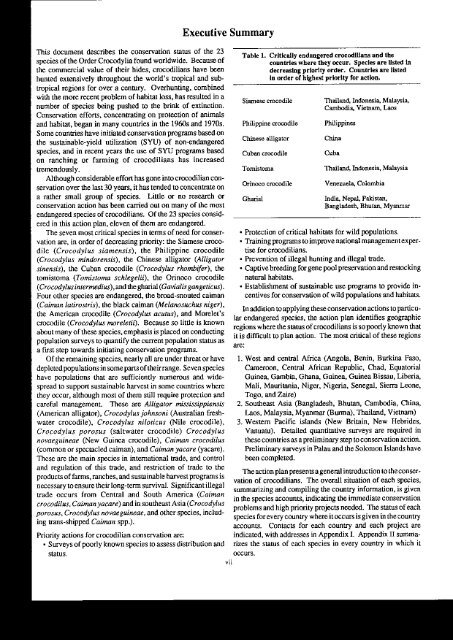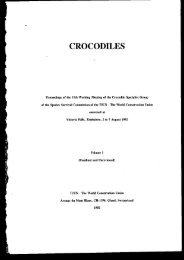size: 7451KB - Crocodile Specialist Group
size: 7451KB - Crocodile Specialist Group
size: 7451KB - Crocodile Specialist Group
You also want an ePaper? Increase the reach of your titles
YUMPU automatically turns print PDFs into web optimized ePapers that Google loves.
Executive Surnmary<br />
This document descritres the conservation sBtus of th€ 23<br />
Table 1. Crltlcrlly €ndangered cro.odlllaN 8nd the<br />
species oflho Order Crocodylia found worldwide. Because of<br />
count.l€s wb€r€ theJ occur. Speclg sre Ust€d ln<br />
$e commercial value of their hides, crocodilians have been<br />
d€c.€ashg prlorlty order. Court l€s rre lbted<br />
hunted extensively throughoul de world's Fopical and subtropical<br />
regions for over a cenury. Overhunting, combined<br />
ln ord€r of hlghest prlorlty lor aclloD,<br />
with the morc rec€nt problem of habitat loss, has resulted in a<br />
Thlil.nd, Indonsia M&laysia<br />
number of species being pushed !o the brink of extircdon.<br />
cmbodia, Vi€rnam, L&s<br />
Conservation effons, conconEating on protection of animals<br />
and habitat, began in many countries in the 1960s and 1970s.<br />
Philippins<br />
Some countries have inilrated conservation proglams bas€d on<br />
the sustalnable-yield utilization (SYLD<br />
Chin.<br />
of non-endangered<br />
species, and in recent years lhe use of SYLI programs based<br />
on ranching or farming of crocodilians has increased<br />
Ilemendously.<br />
Thailu4 In lonesit, Malaysia<br />
Allhough considemble effon has gone into crocodilian conservalion<br />
over the last 30 years, it has tended to concentate on<br />
a rather small group of species. Litde or no rese€rch or Ghdial<br />
India, Nepal, Paljstan,<br />
conservation action has been carried out on many of tho most<br />
Bugladesh, Bhutaa Myamd<br />
endangered species of crocodihans. Of the 23 species considered<br />
in this action plan, elevcn of them are endangered.<br />
The seven most critical species in tcfms of ne€d for conservation<br />
are, in order of decrcasing priority: the Siamese crcco' . Training progIans to impmve national management exper'<br />
. Proleclion of crihcal habitats for wild populalions.<br />
dilc (Crocodtlus ridrr€nris), the Philippine crocodile tise for crocodrlians.<br />
(CrocadJLus mindotensis), l.he Chinese ^llig 6t (Alligator . Prevention of illegal hunting and illcgal trade.<br />
dn€rrir), rhe Cuban crc(.odile (CrocodJlus rhonbifer), rhe . Captrve breeding for gene pool proservation and rcstocking<br />
tomisrom (Tomistoia schlegelii), rhe Orinoco crocodile natural habitaB.<br />
(C r o c o dJl us in E r ncdi &t\, and tE Ehari3J (c av i al i s g a n g e I i c us). . Esrablishment of sustainable use pmgrarns to provide incentives<br />
for conservation of wild populations and habitats.<br />
Four other species arc endangered, the broad-snouted caiman<br />
(Cainan latircstis\, the bl^ck cainan (Melanasuck8 niger),<br />
In addition to applying these conservation actions 10 panicular<br />
endangered sp€cies, the actioo plan idendfies geographic<br />
the Amcrican crocodile (Crccodlus acutus'), altd Morclet's<br />
cr&odile (Clocadtlu: nwdl€rir. Bccause so litde is known<br />
regions wherc the status of crocodilians is so poorly lolown tlat<br />
about many of $eso spccics, emphasis is placed on conducting<br />
it is difficull to plan action. The most critical of these regions<br />
populadon surveys to quantify the current populadon sl,alus as<br />
a first slep towards initiating conservation prognms.<br />
Of the rcmaining species, nearly all are under hreat or have 1. West and central Africa (Angola, Bonin, Burkina Faso,<br />
dcpleted populations in some parts ofthei range, Scven sp€cies Caneroon, Central African Republic, Chad, Equatorial<br />
have populations ftat are suffrciently numerous and widespread<br />
lo support sustainable harvcst in some counEies where Mali, Mauritania, Niger, Nigeria, Senegal, Siern Leone,<br />
Cuinea, Gambia, Chana, Cuinea, Guinea Bissau, Liberia,<br />
lhoy occur, although most of them still require protectlon and Togo, and zairo)<br />
carelul managemcnL The\e xe Allieator n;ssissippiensis 2. Sou6east Asia (Bangladesh, Bhutan, Cambodia, China,<br />
(American alligaior), C.o.odlllr Jbrlso/t (Ausiralian freshwater<br />
crocodilc), Cro codllus niloticus (Nile crocodile), 3. weslem Pacific islands (New Britain, New Hebrides,<br />
Laos, Malaysia, Myanmar (Burma), Thailand, Vietnam)<br />
CracodlLus porostls (saltwarcr crocodile) C/ocodlirr Vanualo). Delailed quantitative surveys are roquired in<br />
no\)aeguineae (New Guinca crocor'lj,le), Cainnn crccodilur these countries as a preliminary slep 10 cons€rvation action.<br />
(common or spcctaclcd caim n\, and Cainnn Jacare (yacarc). Preliminary surveys in Palau and lho Solomon Islands have<br />
Thesc rre fie marn species in intemational trade, and conEol been compleled.<br />
and regulation of this trade, and resEiction of lrade to lho<br />
The action plan prcsents a general infoduction to the conscr'<br />
products of farms, ranches, and sustainable harvesl programs is<br />
vation of crocodilians, The overall siiuation of each species,<br />
necessary to ensure lhcir long-term survival. Significant illegal<br />
summarizing and compiling the counry information, is given<br />
trade occurs from Cenlral and Souft America (Cdir?a,<br />
in $e spe{ies accounLs. indicaring the immediate conservadon<br />
crocadilus, Cainran Jocarc) and in southeast Asia (C.rcodlirr<br />
problems and high priority projecls needed. The sl2tus ofeach<br />
porosus, Crocodylus nova€g,rirede, and othcr specios, including<br />
Eans-shipped Calrdn spp.).<br />
species for every country where it occurs is given in the counry<br />
accounts, Conlacts for each country and oach Fojecl are<br />
Priority actions for crocodilian conseFation are:<br />
indicated, with addresses in Appendix L Appendix II summaries<br />
the status of cach species in every country in which il<br />
. Surveys of poorly known species to assess dislnbution and<br />
sElus.

















